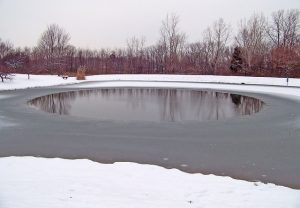 Outdoor play on icy ponds can be fun for kids of all ages as you ice skate, play ice hockey or slip and slide for fun. March temperatures fluctuate, though, and the ice might not be as safe as you think it is. Take precautions and follow several safety tips.
Outdoor play on icy ponds can be fun for kids of all ages as you ice skate, play ice hockey or slip and slide for fun. March temperatures fluctuate, though, and the ice might not be as safe as you think it is. Take precautions and follow several safety tips.
Test the Ice’s Thickness
Even though the pond appears frozen, the ice must be at least four inches thick to support your weight. To test the ice’s thickness, make a small hole with a chisel or auger and insert a tape measure into the hole. Because ice freezes unevenly, you’ll want to make at least one hole every 150 feet to ensure the entire pond is covered with enough ice.
You should also look for other details about the ice as you determine if it’s strong. New ice is stronger than old ice. Additionally,
clear ice is twice as strong as white or snow-covered ice. If the pond is covered in white ice, it should be at least eight inches thick before you walk or play on it.
Dress Appropriately
Any winter outdoor activities require appropriate clothing. You’ll want to wear a base layer that absorbs moisture, a middle layer that provides insulation and an outer layer that protects you from the weather. You also want to wear shoes or boots that offer traction and a helmet that protects your head.
Take a Buddy
Playing on the ice is dangerous even if it’s deep enough, so always take a friend. Also, stay no more than 10 feet apart so that you can help your friend if one of you falls into the water.
What to do if You Fall Through the Ice
Despite following all the safety tips, you may still fall through the ice. Know what to do as you increase your chances of surviving.
- Use your safety tools. A whistle allows you to signal for help, and you can use an ice pick to secure your way back onto the ice.
- Stay calm. Panic consumes valuable energy and time. Plus, flailing around could push you away from the surface you need to grab onto. Try to be intentional and slow about your movements as you move toward the safety of solid ice.
- Don’t stand up when you get out of the water. This action could cause further cracks in the ice. Instead, stay on your stomach or side to distribute your body weight evenly. Then push yourself further onto solid ice and safety.
Playing on the winter ice is fun. Use these safety tips to ensure everyone stays safe while playing, too.





